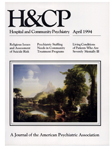The Housing and Neighborhood Conditions of Persons With Severe Mental Illness
Abstract
Objective: This study compared the housing and neighborhood conditions of persons with serious mental illness with those of the general population. Methods: Data were derived from two surveys: the Community Care Survey administered in 1988-1989 in Baltimore, Maryland, and in Cincinnati and Columbus, Ohio, aspart of the national evaluation of the Robert Wood Johnson Foundation Program on Chronic Mental Illness and the American Housing Survey conducted by the U.S. Census Bureau for the Department of Housing and Urban Development. Results: Persons with serious mental illness generally have worse housing and neighborhood circumstances than the overall population. Persons with serious mental illness typically had housing cost burdens that were significantly higher than the general population; their dwellings and neighborhoods often bad higher rates of pbysical deficiencies and other problems, especially crime. Conclusions: Although the relationship between the well-being of seriously mentally ill persons and the condition of their housing and neighborhood has not been established definitively, the results of this study suggest that many persons with serious mental illness are not now achieving adequate housing and its associated benefits.
Access content
To read the fulltext, please use one of the options below to sign in or purchase access.- Personal login
- Institutional Login
- Sign in via OpenAthens
- Register for access
-
Please login/register if you wish to pair your device and check access availability.
Not a subscriber?
PsychiatryOnline subscription options offer access to the DSM-5 library, books, journals, CME, and patient resources. This all-in-one virtual library provides psychiatrists and mental health professionals with key resources for diagnosis, treatment, research, and professional development.
Need more help? PsychiatryOnline Customer Service may be reached by emailing [email protected] or by calling 800-368-5777 (in the U.S.) or 703-907-7322 (outside the U.S.).



